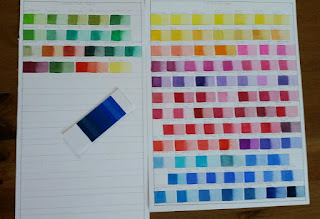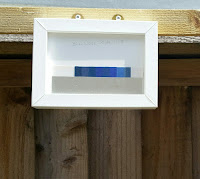In January this year I bought some Blue Wool Scale 1-8 Cards and made lightfastness charts with every watercolour paint that I have in the brands that I own. This means I sometimes have more than one example of a colour to test. I also included known fugitive colours, some accidentally acquired in sets or dot charts, and one - Rose Madder Genuine - bought for the occasion.
The charts were made with swatches on watercolour paper consisting of Mass Tone and a dilution which still gave a clear colour, and the thick aluminium masks were set so that they covered half the swatch. The glass is normal picture frame glass to allow maximum light penetration.
The original intention was to use a light box fitted with UV lights, but as it turned out, the tubes weren't numerous or strong enough. And my electricity meter was whizzing around far to quickly !
So, after setting up the frames and masks and putting everything together, it was all shelved in the dark until the weather was right.
 |
| Watercolour Paint swatches and Blue Wool Scale card 1-8 |
The past week has been dry and even occasionally sunny so the test frames have been hung outside daily, facing as close to South as I can get. I don't wait for sunshine, and hours arent counted as the light here in South Wales is so variable. Any light will do as I have the Blue Wool Scale to compare with.
 |
| Watercolour paint swatches facing South |
 |
| Blue Wool Scale 1-8 masked and hung facing South |
Interim results, at Blue Wool Scale 3 - after just 1 week are interesting.
 |
| Blue Wool Scale showing changes to first 3 swatches |
Aureolin (yellow) PY40 (Daniel Smith)
The colour most noticeably changed. It's gone dirty and brown. My advice, avoid. The last thing any artist needs is a yellow that goes dirty so quickly. There are plenty of lovely yellows to play with that won't change so quickly. If you're really attached to it, maybe do your own Lightfastness Testing.
The colour most noticeably changed. It's gone dirty and brown. My advice, avoid. The last thing any artist needs is a yellow that goes dirty so quickly. There are plenty of lovely yellows to play with that won't change so quickly. If you're really attached to it, maybe do your own Lightfastness Testing.
|
Aureolin PY40 showing colour changing after only 1 week |
Rose Madder Genuine NR9 (W&N)
This is a known fugitive colour and I can't say I know of many who would use it as there are any number of non fugitive alternatives. However, it hasn't changed as quickly or as much as I expected. Watch this space.
This is a known fugitive colour and I can't say I know of many who would use it as there are any number of non fugitive alternatives. However, it hasn't changed as quickly or as much as I expected. Watch this space.
Brilliant Red Violet PV1 (Schmincke)
The expected has happened. The brightness has disappeared across the swatch leaving a reddish purple. It will be interesting to see how this one develops as time goes on.
The expected has happened. The brightness has disappeared across the swatch leaving a reddish purple. It will be interesting to see how this one develops as time goes on.
Brilliant Blue Violet PV1 (Shmincke)
As PV1 above.
As PV1 above.
Opera BV11, PR122 (Turner) and Rose Opera PR81:1 (Sennelier)
Both of these make no claim to lightfastness and it's clear to see why. They have faded substantially in mass tone and diluted.
However W&N Opera PR122 remains bright and unchanged so far.
Both of these make no claim to lightfastness and it's clear to see why. They have faded substantially in mass tone and diluted.
However W&N Opera PR122 remains bright and unchanged so far.
Rose Madder Hue PR81, PR122 (Daler Rowney Aquafine)
This has shown clear changes already. Faded in mass tone and diluted. There are substitutes that won't change.
This has shown clear changes already. Faded in mass tone and diluted. There are substitutes that won't change.
Prussian Blue PB27 (W&N, Schmincke)
This has faded substantially. If it's a favourite of yours, you may wish to do your own lightfastness Testing.
More on Lightfastness and Colour
Lightfastness Testing #2 - Results
How Many Colours Do You Need To Paint flowers?
The Problem Of PY153 - New Gamboge, Indian Yellow
This has faded substantially. If it's a favourite of yours, you may wish to do your own lightfastness Testing.
 |
| The main watercolour swatches - some showing changes |
More on Lightfastness and Colour
Lightfastness Testing #2 - Results
How Many Colours Do You Need To Paint flowers?
The Problem Of PY153 - New Gamboge, Indian Yellow

So useful Polly! Thank you for doing these tests. I had a feeling aureolin was best steered away from, but not through testing just by personal choice. Great blog x
ReplyDeleteThank you so much !
ReplyDelete